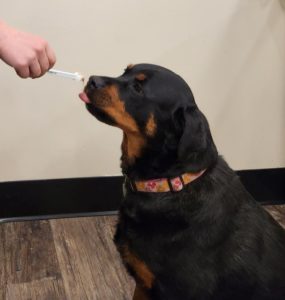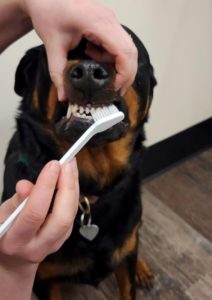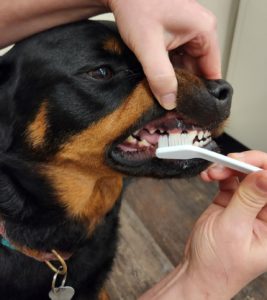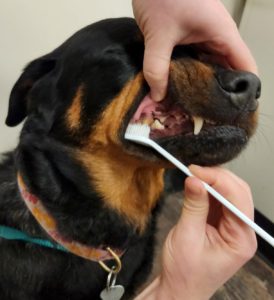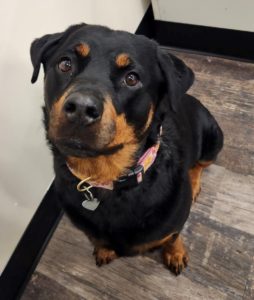Pets need dental care just like people do. Veterinarians recommend taking your dog or cat to get a teeth cleaning annually, and in the meantime, brushing your pet’s teeth daily to prevent dental disease. For both animals and humans, tooth brushing is the most successful method for removing plaque from teeth.
Getting your dog or cat on board with daily brushing may take a bit of time and practice, but the health benefits will be worth the effort. With the help of rewards like food and toys, pets are more likely to adopt new routines and learn behaviors; over time, they may even come to enjoy getting their teeth brushed!
Tips for brushing your dog’s teeth
- Involve the whole family. Kids can have a lot of fun taking care of their pet!
- Pick a time of day that will be habit forming for you.
- Start by introducing a toothbrush and toothpaste in a positive way.
- Gradually increase use of a toothbrush in the mouth over a 1-2 week period, with the goal of brushing the outside surfaces of all teeth each time.
- Gently brush each tooth or section of teeth with three back-and-forth strokes, keeping the bristles at a 45-degree angle pointing toward the gums.
- Give plenty of rewards.
Recommended dental care products
- Toothbrush: Use an adult- or child-sized soft-bristle toothbrush dedicated to one pet (don’t share a toothbrush with other pets). You can also try a silicone finger brush. The bristle action of the toothbrush is the most important component of the brushing process, because it mechanically disrupts the plaque layer.
- Toothpaste: Enzymatic pet toothpaste adds both a beneficial biological function and a rewarding flavor for your pet to enjoy.
- Dental chews: Using dental chews approved by the Veterinary Oral Health Council every day or every other day are beneficial in addition to daily toothbrushing.
Step-by-step guide to brushing your dog’s teeth
- Give treats and introduce the toothbrush and toothpaste.
- Gently hold the lips up so you can see the teeth and where the toothbrush needs to go.
- Gently brush the teeth back and forth with the bristles pointing at a 45-degree angle toward the gums. Use only light pressure; the bristles should not flare out or flatten against the teeth. Too much pressure will be uncomfortable for your pet and more irritating to the gums.
- Take short breaks as needed to give treats or rewards until all teeth are brushed.
For more information on brushing your pet’s teeth, visit the dentistry and oral surgery service, and talk with your veterinarian about developing a dental care plan for your dog or cat.
